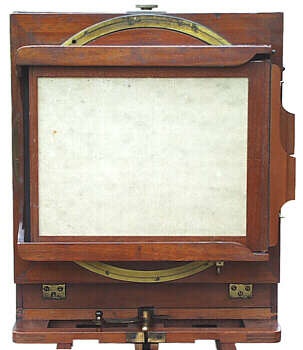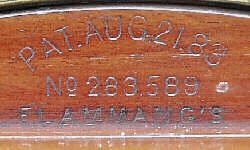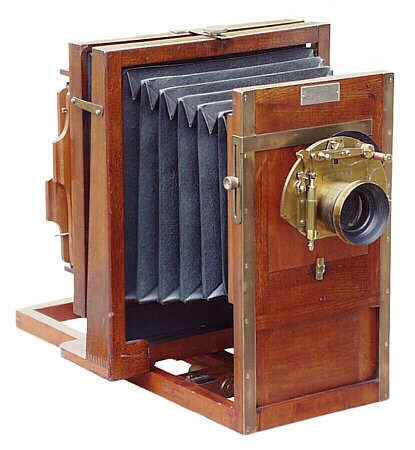|
|




Copyright ©2002 by Rob Niederman - ALL RIGHTS RESERVED
Also refer to:
• Flammang's Patent Revolving Back Camera (front focus)
• Flammang's Revolving Back Camera References page
Return to the View Cameras page
• Flammang's Patent Revolving Back Camera (front focus)
• Flammang's Revolving Back Camera References page
Return to the View Cameras page
An interesting design challenge in early view cameras was to figure
out a way to reposition the ground glass frame for portrait (vertical)
or landscape (horizontal) orientations. The earliest cameras had large
square ground glass assemblies that held plates in either position.
Another approach was to simply turn the entire camera onto its side -- which was somewhat impractical considering the size of most view and field cameras. In 1882, E.& H.T. Anthony attacked the problem by creating a novel rotating back/bellows design - refer to the Anthony's Phantom Camera page.
To avoid possible patent infringements with Anthony, The American Optical Company used two designs by Mathias Flammang. Both designs were assigned to the Scovill Manufacturing Company for exclusive use on their photographic apparatus.
Flammang's first design was a simple reversible back. The ground glass frame/mount was removed from the camera back, rotated 90 degrees, and reattached. The reversible back required a larger square shaped rear standard and was featured on cameras such as the St. Louis Reversible Back Camera and other models.
Flammang's second design, an integral (non-removable) back that rotated on the rear standard, was originally offered by the American Optical Company on Flammang's Patent Revolving Back Cameras. The rotating back was patented on August 21, 1883 (patent #283,589) and also found on Scovill's Revolving Back (field) and Empire Portrait (studio) cameras. As a note, cameras made by the Scovill Manufacturing Company for the American Optical Company had a higher quality finish and were more expensive.
Another approach was to simply turn the entire camera onto its side -- which was somewhat impractical considering the size of most view and field cameras. In 1882, E.& H.T. Anthony attacked the problem by creating a novel rotating back/bellows design - refer to the Anthony's Phantom Camera page.
To avoid possible patent infringements with Anthony, The American Optical Company used two designs by Mathias Flammang. Both designs were assigned to the Scovill Manufacturing Company for exclusive use on their photographic apparatus.
Flammang's first design was a simple reversible back. The ground glass frame/mount was removed from the camera back, rotated 90 degrees, and reattached. The reversible back required a larger square shaped rear standard and was featured on cameras such as the St. Louis Reversible Back Camera and other models.
Flammang's second design, an integral (non-removable) back that rotated on the rear standard, was originally offered by the American Optical Company on Flammang's Patent Revolving Back Cameras. The rotating back was patented on August 21, 1883 (patent #283,589) and also found on Scovill's Revolving Back (field) and Empire Portrait (studio) cameras. As a note, cameras made by the Scovill Manufacturing Company for the American Optical Company had a higher quality finish and were more expensive.
Multi-Lens Cameras | View Cameras | Self-Casing Cameras | Solid Body Cameras | References & Advertisements
Home | What's New | Show Schedule | Wanted | For Sale | Links | Site Map | Email
Home | What's New | Show Schedule | Wanted | For Sale | Links | Site Map | Email
Flammang Rear Focus Pattern (whole-plate format)
Double Swing Back, Prosch Triplex Shutter
Double Swing Back, Prosch Triplex Shutter
Flammang's Patent Revolving Back Camera included a canvas bag and made in standard formats from 4 x 5 inches to 25 x 30 inches.
Considering the large size of this whole-plate camera (15" high x 18-1/2" deep x 11-1/2" wide), I suspect that the 25 x 30 inch model
must have been merely enormous -- probably the size of a small tool shed. The double swing model shown here sold for $45 in 1888.
This was a very expensive camera at the equivalent of $853 in year 2000 dollars!
Above: Flammang's 1883 patent is impressed into the wood above
the plateholder and below the brass rotating ring.
Left: View of Flammang's patented revolving back. The large brass lever at the bottom of the camera unlocks the sliding back for focusing. A small brass knob (above the center rail) locks the second back swing.
Left: View of Flammang's patented revolving back. The large brass lever at the bottom of the camera unlocks the sliding back for focusing. A small brass knob (above the center rail) locks the second back swing.
Flammang's cameras were offered in front and rear focusing body patterns. The Flammang's camera on this page is a fine example of
the rear focusing pattern in the whole-plate (6-1/2 x 8-1/2 inch) format. Other than the patented revolving back feature, the body is
nearly identical to Scovill's New Reversible Back Acme View Box. The camera has a Prosch Triplex shutter with unmarked rapid
rectilinear lens, mahogany body, brass trim and cloth bellows. The lighter color wood finish and bottom mounted back tilt may indicate
that this is an early model, c1885.
An unexpected bonus was also found on the camera. The name L.B. Kirsten, Pho. is impressed into the wood under the front standard - most likely the owner of a small studio or an amateur photographer operating in the eastern part of the United States. Since I am interested in uncovering the original owners of cameras in the collection, please feel free to contact me regarding any information on Kirsten (including images).
An unexpected bonus was also found on the camera. The name L.B. Kirsten, Pho. is impressed into the wood under the front standard - most likely the owner of a small studio or an amateur photographer operating in the eastern part of the United States. Since I am interested in uncovering the original owners of cameras in the collection, please feel free to contact me regarding any information on Kirsten (including images).
Flammang's Patent Revolving Back Camera, c.1883-98
American Optical Company, Scovill Mfg. Co., NY.
American Optical Company, Scovill Mfg. Co., NY.
